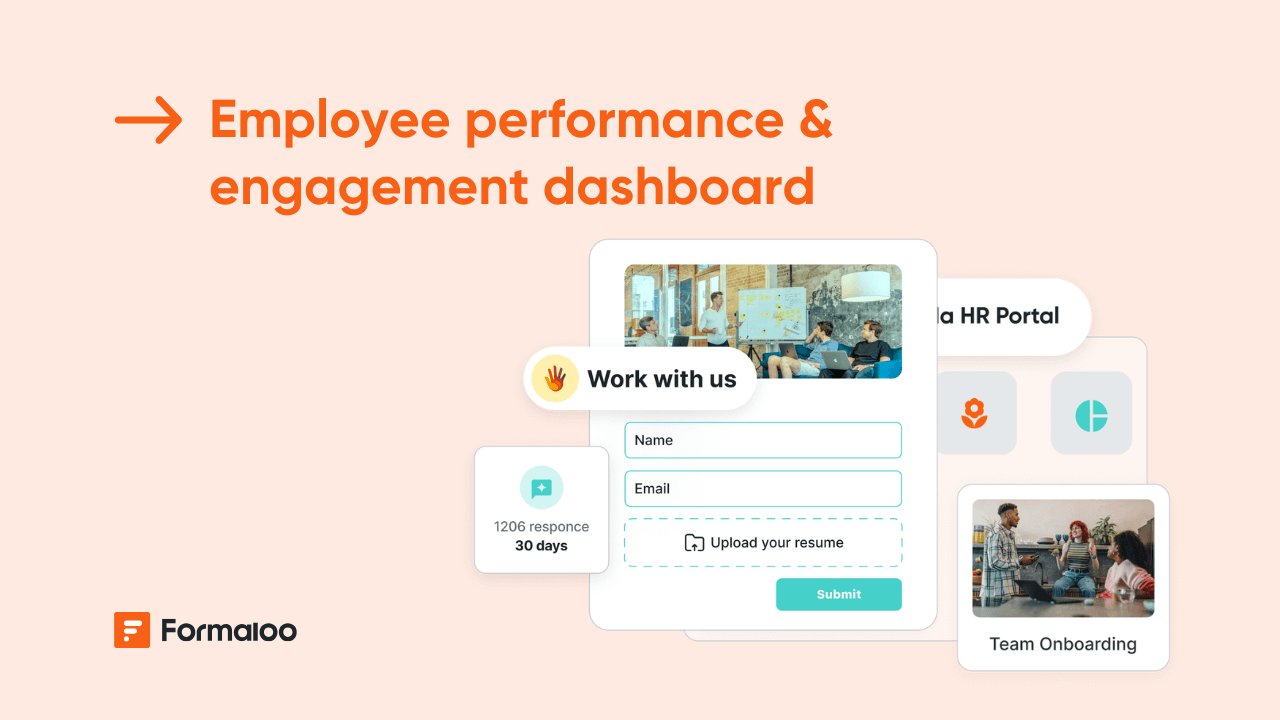How to build a team performance review form with scoring logic
Create a performance review form that scores team members automatically and summarizes their results with built-in logic and reports.
.jpg)
Evaluate performance fairly with automated scoring
In this guide, you’ll build a team performance review form that calculates scores based on answers, averages ratings across criteria, and gives you instant insights into strengths and growth areas. Ideal for HR teams, managers, and department leads.
📘 Learn more: Create your first form, app, or portal in a flash
Step 1 — Create your performance review form
Start from your workspace and click + New → Form. You can start from scratch or choose the Employee Performance Evaluation or Feedback Form template from the Template gallery.
Or use Magic Create,describe what you need, for example:
“A performance review form that scores each competency and calculates total performance automatically.”
Why this matters: starting from a structured form ensures your scoring logic is accurate and consistent.
📘 Learn more: How to create a form
Step 2 — Add key performance criteria fields
Include both rating and descriptive questions for balanced evaluation.
Core evaluation sections:
- Communication skills (1–5 rating)
- Collaboration and teamwork (1–5 rating)
- Goal achievement (1–5 rating)
- Problem-solving and adaptability (1–5 rating)
- Attendance and punctuality (1–5 rating)
- Manager comments (long text)
💡 Tip: use rating scales or single-choice fields with numeric values (1–5) for clean score calculations.
📘 Learn more: Form editor and field types
Step 3 — Add variable fields to calculate scores
Use variable fields to convert each answer into a numeric score and then sum them automatically.
Example setup:
- @total_score = (@score_communication + @score_teamwork + @score_goals + @score_problem_solving + @score_attendance)
- @average_score = @total_score / 5
Why this matters: variables let you measure performance instantly without manual calculations.
📘 Learn more: How to add and calculate scores using variable fields
Step 4 — Add logic to categorize performance levels
Go to Settings → Advanced logic and create simple conditions to label results:
- If average_score ≥ 4.5 → Assign “Outstanding”
- If average_score ≥ 3.5 and < 4.5 → Assign “Strong performer”
- If average_score ≥ 2.5 and < 3.5 → Assign “Needs improvement”
- If average_score < 2.5 → Assign “Underperforming”
You can also show a custom message on the ending page summarizing results.
📘 Learn more: How to add advanced logic to your form
Step 5 — Display final results dynamically
Add a content field at the end of the form to show calculated results:
“Your total score is @total_score and your average rating is @average_score.
Overall performance: @performance_level.”
💡 Tip: use answer piping to display personalized data instantly after submission.
📘 Learn more: How to create and use answer piping
Step 6 — Automate notifications and PDF reports
Go to Settings → Advanced logic or Notify tab to send automatic results:
- To the manager: include a full score breakdown and comments.
- To HR: send the complete PDF report for filing.
- To employee (optional): share a summary email with their average score and key feedback.
Attach a custom PDF that pulls in scores and feedback dynamically.
📘 Learn more: How to create and send custom email templates
📘 Learn more: How to generate custom PDFs using templates
Step 7 — Create dashboards to visualize performance
In your Results → Responses tab, create visual summaries for quick insights:
- Table view: view all employees with total and average scores.
- Charts: visualize performance distribution by team or department.
- Kanban view: group employees by performance level (Outstanding, Strong, etc.).
📘 Learn more: How to showcase charts based on form responses
Step 8 — Build an HR and manager portal
From your workspace, create a Portal to organize all review data:
- Page 1: All employee reviews (HR view)
- Page 2: My team’s evaluations (Manager view)
- Page 3: Individual performance reports (Employee access)
Set access filters so each role only sees their relevant data.
📘 Learn more: How to create a portal and manage users’ access
Step 9 — Automate next-step actions
Use on-update logic to trigger follow-up actions:
- If performance_level = Needs improvement → Notify HR for coaching plan.
- If performance_level = Outstanding → Send email to manager for reward nomination.
📘 Learn more: What is on-update logic and how it works
Step 10 — Use AI to summarize reviews
Enable AI Analyze to summarize team insights automatically:
- “Average performance per department.”
- “Common strengths and weak areas.”
- “Employees showing consistent growth.”
📘 Learn more: Uncover insights and trends in your data with AI Analyze
Pro tips
- Turn completed reviews into employee history records with linked rows.
📘 Learn more: What are linked rows and how to use them
Example scenario
A manager fills out a team member’s review form, rating each area from 1–5. The system calculates a total and average score, labels it “Strong performer,” and emails both HR and the employee a summary PDF. The HR dashboard updates in real time, showing department averages and performance trends.
📘 Learn more: How to add and calculate scores using variable fields
FAQ
- Can I include self-evaluation and manager review in one workflow?
Yes, create two linked forms and connect them using shared fields like employee ID, or linked row. - Can I weigh some questions more than others?
Absolutely, use variables with multipliers (e.g., @goal_score * 2) for weighted scoring. - Can I export performance summaries for reports?
Yes, export tables or generate custom PDFs automatically for each employee.
📘 Learn more: How to export table data into Excel
Your scoring-based review system is live, start tracking growth automatically
You’ve built a performance review form that scores and categorizes team results instantly, helping you evaluate fairly and make smarter HR decisions. Keep enhancing it with logic, automation, and AI-driven summaries.
📘 Learn more: Build personalized and time-saving flows with logic, automations, and AI
Last updated October 2025












